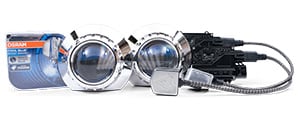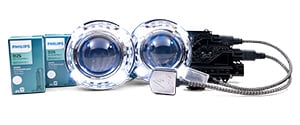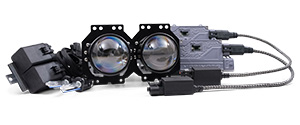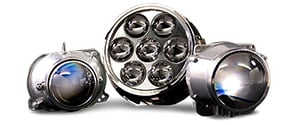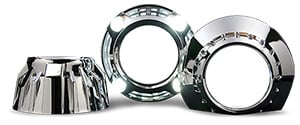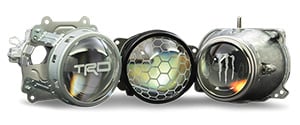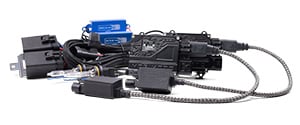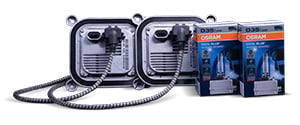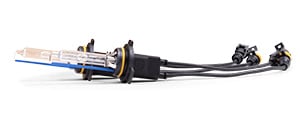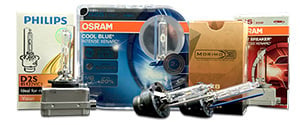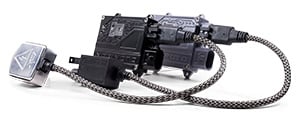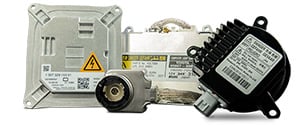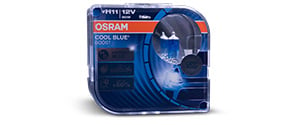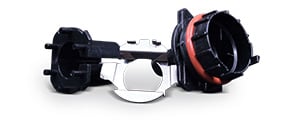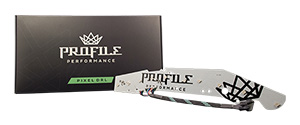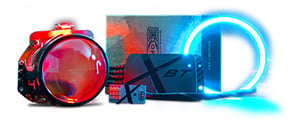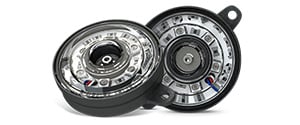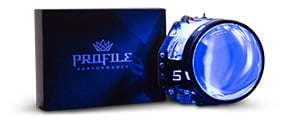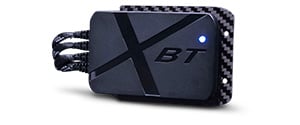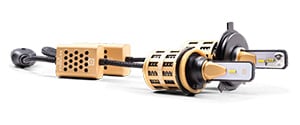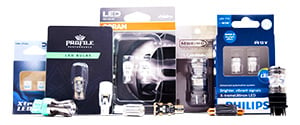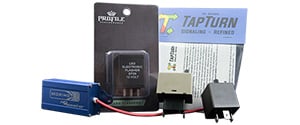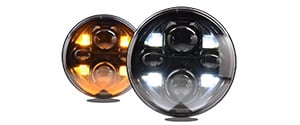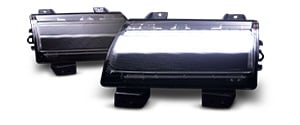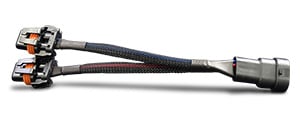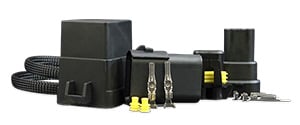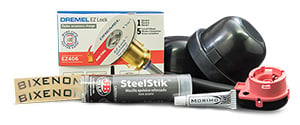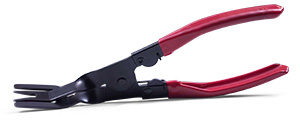In 1993, BMW became the first automaker to offer a vehicle with HID headlights. Powered by a monster sized HID ballast (around the size of a brick) that ran off AC Power, it utilized a bulb simply designated as “D1.” The first American-made HID headlight system was offered in 1996 by Lincoln on their MKVIII. Their Sylvania-produced system was one of a kind since it ran on DC current. Due to the design’s poor reliability relative to AC systems, when Osram took over Sylvania their “Type 9500” DC ballast was discontinued. Today, ballasts run on AC current, are compact in size, and have an expected service life of eight to ten years.
THINGS TO CONSIDER
1. What kind of projectors are you using? The projectors ultimately determine the bulb size, which determines compatibility with ballasts. For example, projectors such as the FX-R Bi-xenon, TL Bi-xenon, or S2000 low beam all take D2S bulbs – meaning you’ll need a ballast with an output for the D2 bulb base. Projectors like the Morimoto Mini H1 take a H1 HID bulb which will have AMP inputs, and therefore need ballasts with AMP outputs.
AMP > D2S Adapters: Though you could always use a set of AMP to D2S or D2S to AMP adapters to force compatibility between ballasts and bulbs, it’s definitely more reliable when the ballast is just naturally compatible with the intended bulbs from the start. Sure adapters work, but they add a weak link in a high-voltage line, so they shouldn’t be used as a permanent solution here.
The Retrofit Source offers four options for those seeking D2S compatible ballasts:
1. Denso Slim
2. Matsushita Gen V
3. Morimoto 3Five D2S
4. Morimoto 5Five D2S
And three options for those needing AMP compatible ballasts:
1. Morimoto 3Five
2. Morimoto 5Five
3. Denso Slim with AMP conversion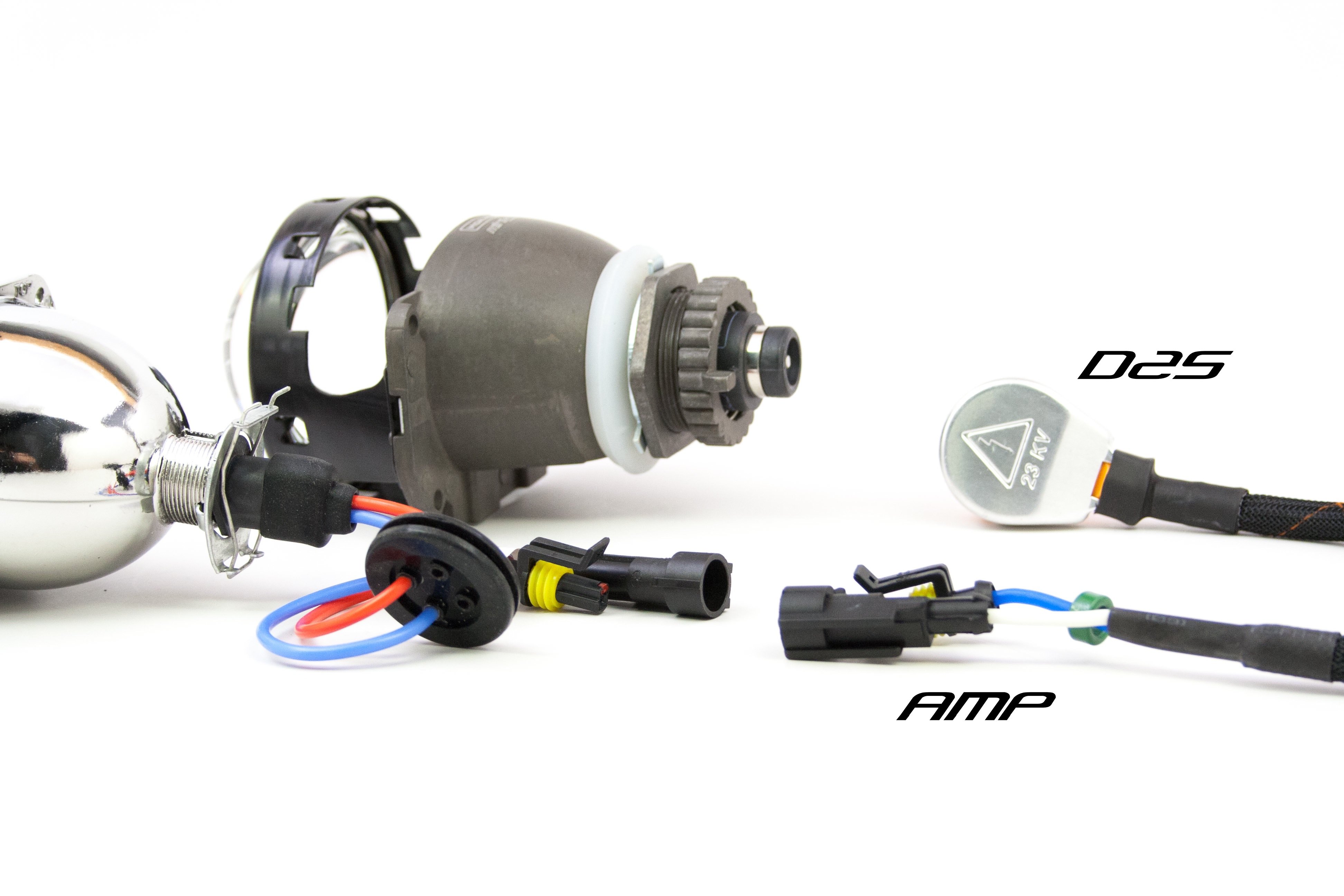
2. What wattage is right for you? When it comes to ballasts, the wattage rating will determine the intensity of light produced by the bulb. The two most common options are 35w and 55w, but here and there, you’ll see 70-100w ballasts too. Without exception, all vehicles with factory-equipped HID headlights run 35w ballasts. With the variety of choices here, what’s right for you?
35W:
— Provides the best everyday and long term reliability.
— Runs the bulbs at the coolest possible operating temperatures, aiding in the longevity of crucial reflective finishes inside the projectors.
— Produces a light output that’s still more than adequately bright, especially when coupled with a good set of projectors.
— Bulbs will run at their rated Kelvin/color temperature.
50W:
— Provides approximately 25-30% more intensity in the light output.
— Reduced reliability and lifespan of the ballast itself and the bulb.
— Added heat can potentially reduce the reflectivity inside projectors after prolonged use, especially if the projector is small in size (making it less capable of absorbing and shedding the heat)
— Washes out the color of the HID bulb (if that bulb is not specially made for 55w ballasts)
70-100W:
— Extremely bright, glaring output even if used in a projector based headlight.
— Poor short term and long term reliability which also affects the bulbs.
— High potential for over-heating and ruining crucial surfaces inside headlights/projectors.
— Consumes a lot of power from the car’s electrical system.
3. Should you use OEM or Aftermarket Ballasts?The more expensive OEM ballasts such as the Matsushita or Denso units will not make your headlights any brighter than a less expensive aftermarket ballast. Though, there is a reasonable margin of quality between OEM-made and really cheap aftermarket HID kit ballasts; mostly in terms of long-term reliability. OEM ballasts also tend to warm the bulbs up to their full operating intensity a few seconds faster than aftermarket units.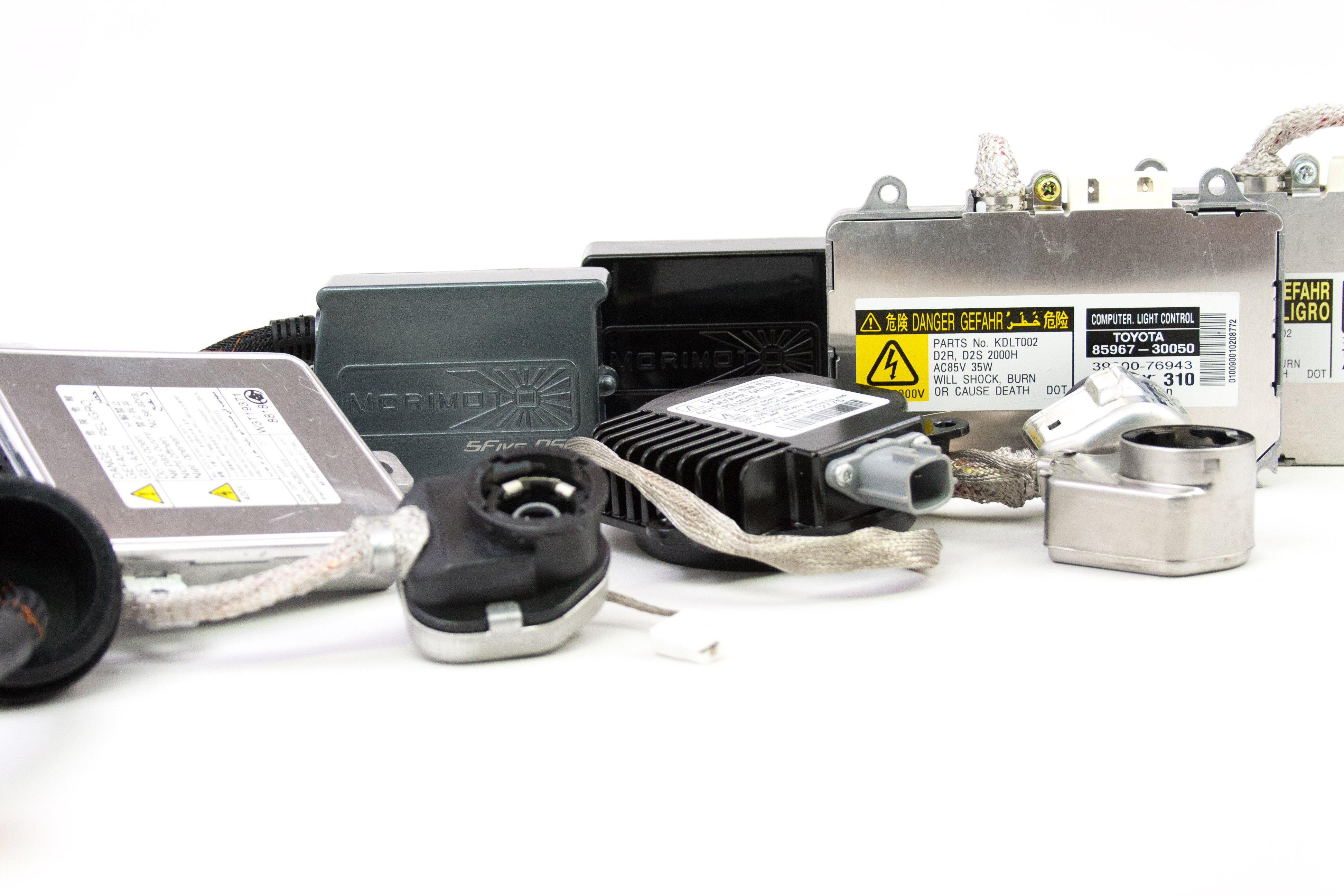
Indicators of cheap quality aftermarket ballasts:
— Generally never available with a dedicated D2S output, only AMP versions available.
— Plastic housings with cheap hardware, lack of any kind of quality materials.
— Super slim design – from Alibaba to the eBay special-these are all the same exact ballast
— In broken English, the description refers to their origin as “Philips” or “German” made. Come on.
The ballasts or entire HID kit costs ~$30, how can a quality product be produced, imported, and re-sold for $30 and still produce a profit at that price? Makes you wonder the cost of components or R&D going into them in the first place, doesn’t it? (Though that doesn’t stop other companies from selling the same POS for $200-$300 just to give consumers the illusion of it’s supposed high quality)
One downside to OEM vs. aftermarket ballasts is that the OEM ones typically are not as “waterproof’ as the aftermarket units. This is because they’re usually partially or completely mounted inside a headlight assembly on their original application. Aftermarket ballast manufactures know that their ballasts will be exposed to the elements, so they’re typically designed with fully sealed casings. Now we can offer a full potting/waterproofing service for the OEM Ballasts to protect them for $100, but Morimoto ballasts are not only externally sealed from the elements, but the electronics are covered with rubber potting compound – protecting them from failure even if submerged completely underwater.
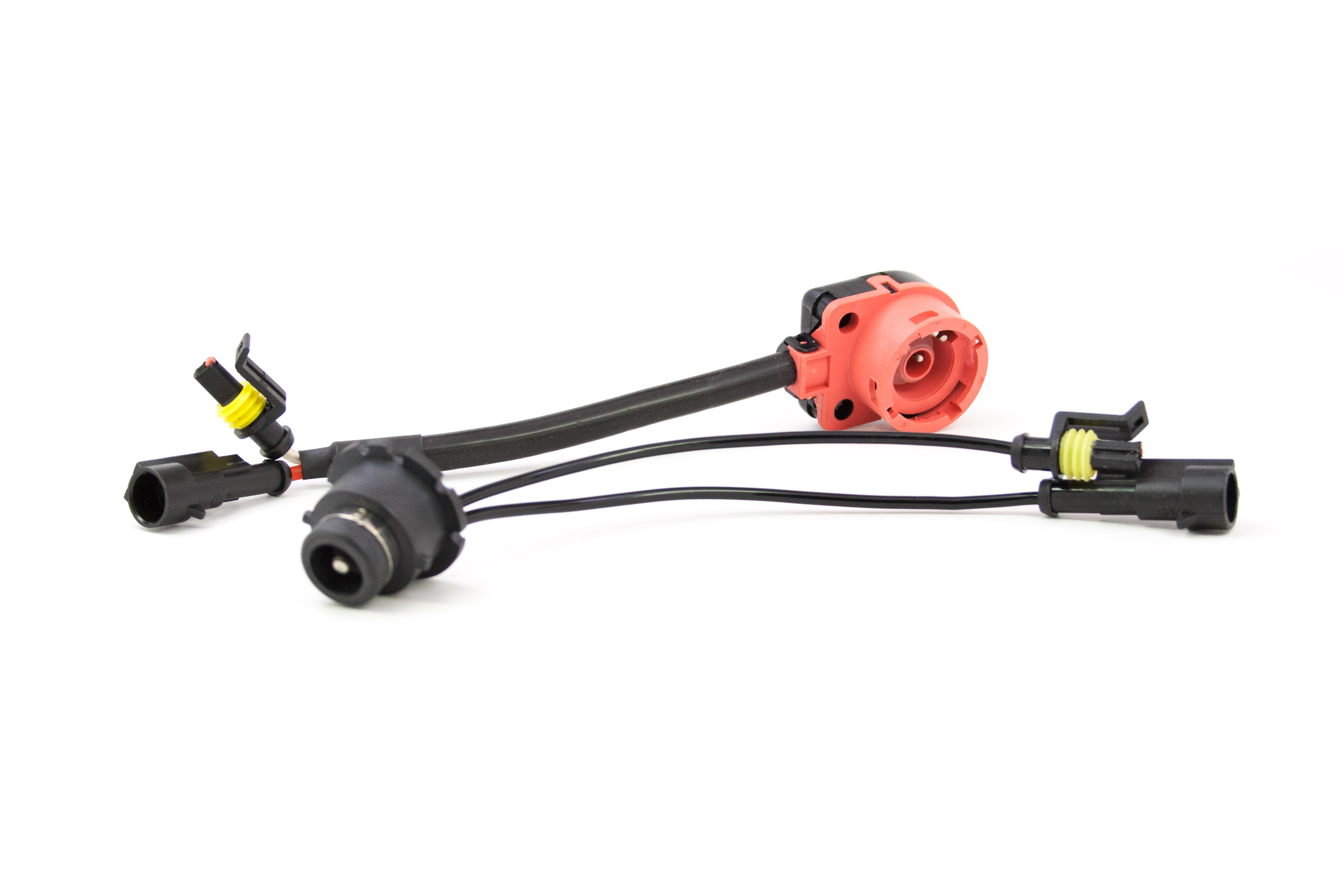
4. What kind of space do you have available? In most cases, the size of a ballast won’t really matter too much, but if space is tight under the hood (especially close to the headlights) this may be something to consider. Retrofitters working on motorcycles should definitely pay attention here too, especially if you have no fairings at all. Plan ahead to make sure that:
— You have space behind or underneath the headlight housings to mount the ballast
— That the specified output length (from computer to bulb) will be long enough to meet your needs.
5. How important is a good warranty to you? As the main component responsible for running your headlights – it’s important to make sure you’ll be backed up in case of failure. Aside from picking out a high quality ballast to begin with – picking a vendor to back it when in need is also a decision of importance.
— How long is the warranty period?
— Is the company that sold it so well-established that they’ll even be around next year to honor their great “lifetime warranty”?
— How easy is it to make a warranty claim? If your ballast dies, do you have to return it for “inspection” or “service” before you get a replacement?
OUR RECOMMENDATION FOR RETROFITTERS
The Morimoto line of ballasts offer the most bang for the buck. They have a great track record for reliability, surprisingly fast warm up time, an unbeatable warranty/replacement policy, and a great looking design that’s not only compact, but is also waterproof and mounts anywhere. If you’re an OEM or nothin’ kinda guy, go for the Denso’s. In our entire history, we’ve replaced very few due to failure. Take care of them by mounting them in a moisture-free environment, and they’ll likely take care of you forever too.
FURTHER READING
BALLASTS START UP IN THREE PHASES:
1. Ignition:
The ballast sends a high voltage pulse through its output similar to a spark plug which travels across the electrodes in the HID bulb, ionizing the halide salts and xenon gas inside it’s capsule to create light.
2. Initial phase/warm up:
The bulb is driven with a controlled overload from the ballast. Here, the bulb’s capsule is still operating at high voltage and the temperature is rising quickly, vaporizing the halide salts and making the light output from the bulb spectrally complete – which fills out the beam pattern. The resistance between the electrodes also falls; the electronic ballast control gear registers this and automatically switches to continuous operation.
3. Continuous operation:
All metal salts are in the vapor phase, the arc has attained its stable shape and the lumen output from the bulb is maxed out. The ballast now supplies stable electrical current so the bulb won’t/shouldn’t flicker. In D1 and D2 systems, the stable operating voltage is AC85V, and AC42V in D3/D4 systems.
CROSS COMPATIBILITY BETWEEN BALLASTS AND BULBS:
Ballasts designed for use with D2S/D2R bulbs:
— The igniter is part of the ballast system.
— AC85V stable current for bulbs containing mercury
— The most commonly used kind for retrofits because the bestperforming projectors use D2S bulbs.
Ballasts designed for use with D1S/D1R:
— The igniter is part of the bulb, not part of the ballast system.
— AC85V stable current for bulbs containing mercury
— Becoming more common in OEM applications, but not widely used for retrofitting because projectors that use these bulbs lack in performance.
Ballasts designed for use with D3S/D3R:
— The igniter is part of the bulb, not part of the ballast system.
— AC42V stable current for mercury-free HID bulbs
— Most common in late-model American and European made applications from Audi, GM, and Ford.
Ballasts designed for use with D4S/D4R bulbs:
— The igniter is part of the ballast system.
— AC42V stable current for mercury-free HID bulbs
— Originated and still most common in Toyota/Lexus applications in their efforts to be eco friendly. Generally a bit more bright, but not quite as white!
Ballasts designed for use with D4S/D4R bulbs:
— The igniter is part of the ballast system.
— AC42V stable current for mercury-free HID bulbs
— Originated and still most common in Toyota/Lexus applications in their efforts to be eco friendly. Generally a bit more bright, but not quite as white!
I WANT TO USE AN OEM BALLAST WITH AN AFTERMARKET TYPE BULB, OR VICE VERSA:
D2S/AMP adapters:
— Allows the use of D2S/D2R bulbs with ballasts made for AMP connector bulbs.
AMP/D2S adapters:
— Allows the use of AMP connector bulbs with OEM ballasts made for D2 series bulbs.
Output conversion:
— If the igniter is not contained in the D2 socket, the socket can be cutoff completely, and replaced with AMP connectors for a more permanent/reliable setup. We offer this service on our Denso ballasts.
Is brighter always better? Looking for a brighter output? One way to make your bulbs burn brighter would be to select 55w high output ballasts. All OEM applications use standard 35w units, but if you’re a retrofitter looking to put the most possible light on the road, then these ballasts are for you. 55w bulbs are also available, and highly recommended for use with these powerful ballasts
You can use 55w ballasts with standard 35w bulbs, but the life of the bulb will be shortened a bit, and their color will Wash Out a bit. Again, OEM applications use 35w ballasts, and when coupled with a high performance projector, you’ll really be putting plenty of light on the road even going that route. Some may argue that 55w ballasts pump up the foreground light so much that your eyes will adjust to such intense light so close, ultimately reducing long distance vision. In general, TRS advocates the use of 35w ballasts for most users and their applications.
I am using a bi-xenon projector, do I need a “bi-xenon” ballast? No, HID bulbs and ballasts do not need to be bi-xenon specific when used in a projector based system to be capable of producing light for low and high beam modes.
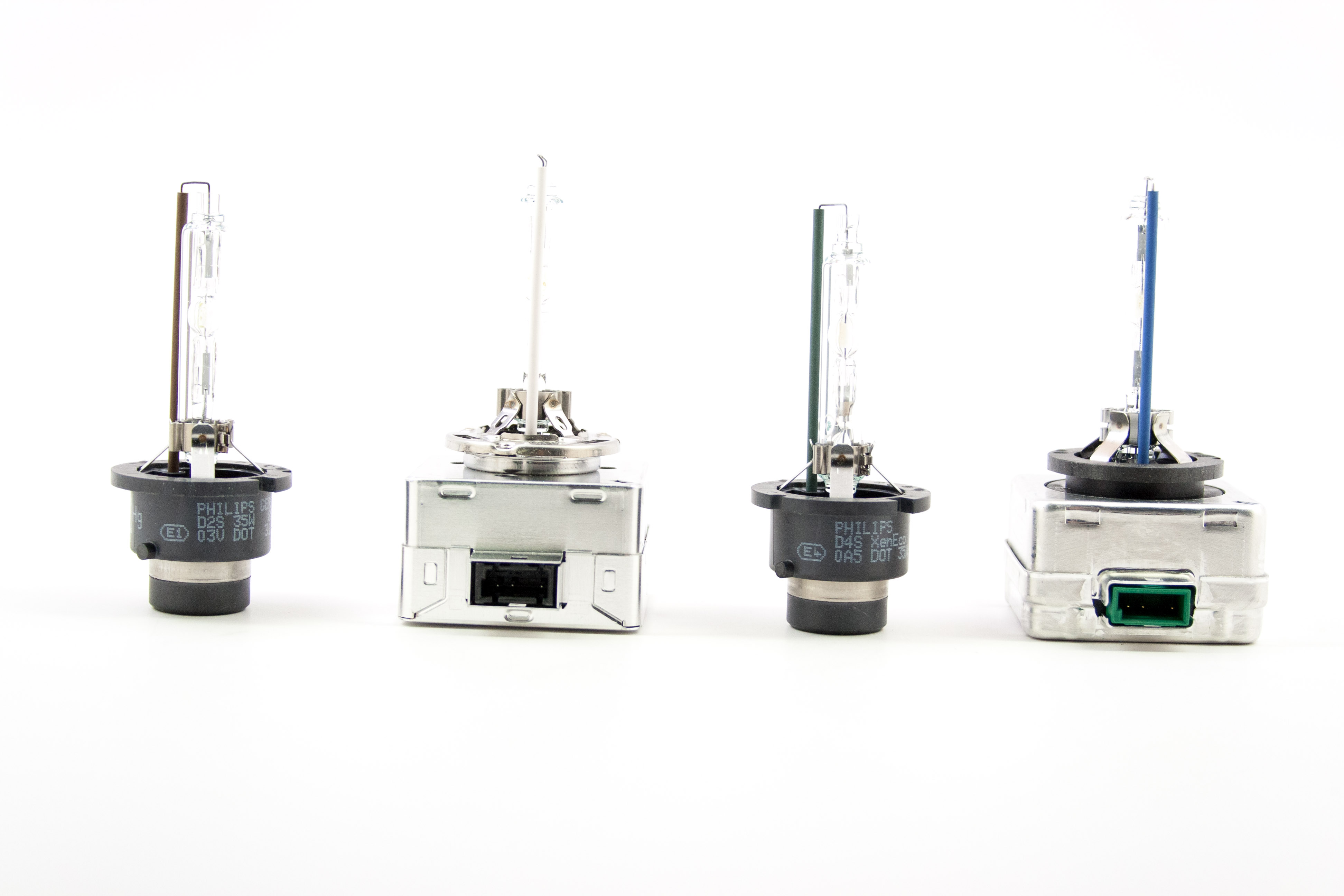
.png)
